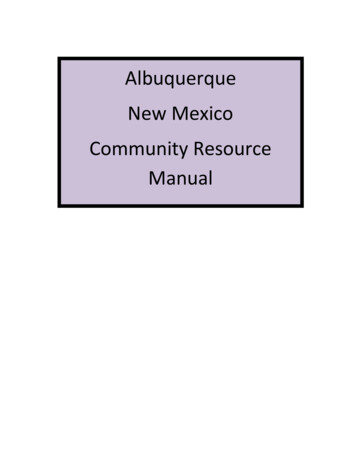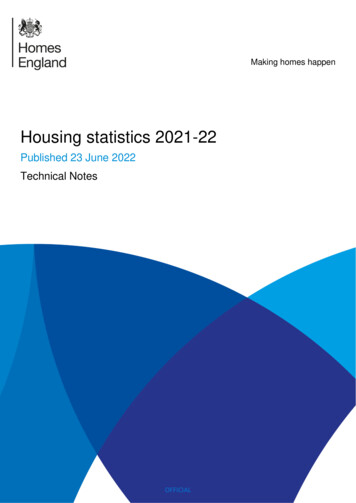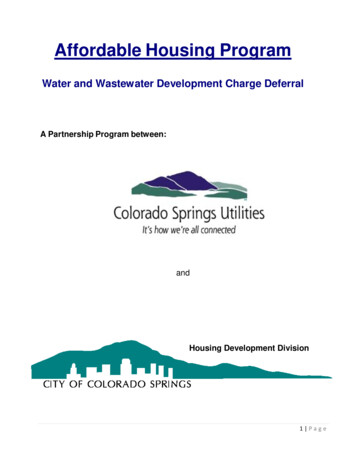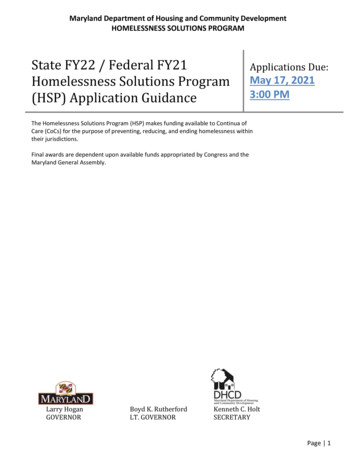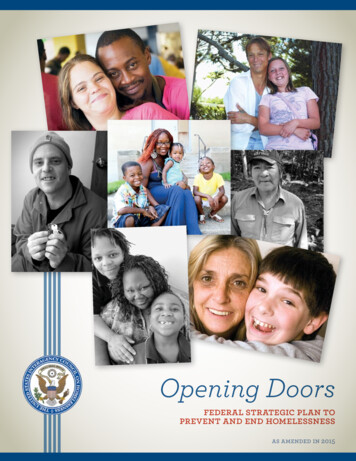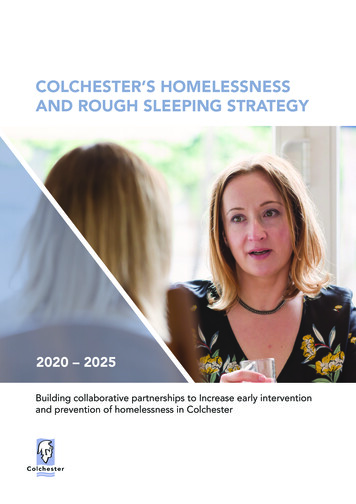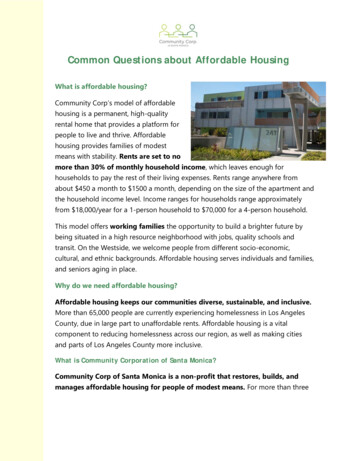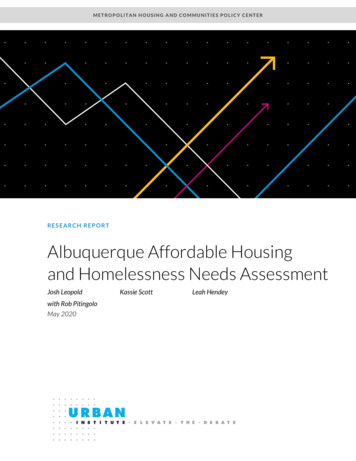
Transcription
METROPOLITAN HOUSING AND COMMUNITIES POLICY CENTERRE S E AR CH RE P O R TAlbuquerque Affordable Housingand Homelessness Needs AssessmentJosh Leopoldwith Rob PitingoloMay 2020Kassie ScottLeah Hendey
AB O U T T HE U R BA N I NS T I T U TEThe nonprofit Urban Institute is a leading research organization dedicated to developing evidence-based insightsthat improve people’s lives and strengthen communities. For 50 years, Urban has been the trusted source forrigorous analysis of complex social and economic issues; strategic advice to policymakers, philanthropists, andpractitioners; and new, promising ideas that expand opportunities for all. Our work inspires effective decisions thatadvance fairness and enhance the well-being of people and places.Copyright May 2020. Urban Institute. Permission is granted for reproduction of this file, with attribution to theUrban Institute. Cover image by Tim Meko.
ContentsAcknowledgmentsivExecutive SummaryvAlbuquerque Affordable Housing and Homelessness Needs Assessment1Housing Needs2Program Inventory and Funding19Recommendations22Improve Leadership and Coordination23Increase Development of Market-Rate Housing24Boost Development and Preservation of Affordable Housing26Expand Access to Tenant-Based Rental Assistance29Improve the Homeless Service System34Conclusion38Notes39References41About the Authors43Statement of Independence44
AcknowledgmentsThis report was funded by the City of Albuquerque. We are grateful to them and to all our funders, whomake it possible for Urban to advance its mission.The views expressed are those of the authors and should not be attributed to the Urban Institute,its trustees, or its funders. Funders do not determine research findings or the insights andrecommendations of Urban experts. Further information on the Urban Institute’s funding principles isavailable at urban.org/fundingprinciples.We thank Lisa Huval, deputy director of housing and homelessness, for her thoughtful feedback ondrafts of this report and our Urban colleague Mary Cunningham for her technical review. We would alsolike to acknowledge all the people we interviewed for this report and thank them for generously sharingtheir time and insights with us.IVACKNOWLEDGMENTS
Executive SummaryThe City of Albuquerque is at a critical moment in its efforts to provide affordable housing and reducehomelessness. The number of renter households with extremely low incomes (households whoseincome is at or below 30 percent of the area median income) has increased while the supply of rentalunits affordable to them has decreased. More households are struggling to pay their rent, and asaffordable housing has become less available, homelessness has increased.1 From 2013 to 2019, streethomelessness in Albuquerque nearly quadrupled—from 144 to 567 people. And the COVID-19pandemic is likely to exacerbate housing instability among these vulnerable households.In 2019, the City of Albuquerque asked the Urban Institute to assess the housing needs of renterhouseholds with extremely low incomes and people experiencing homelessness. The city hopes to usethe report as a first step to creating a road map for reversing current trends. We conducted a two-partanalysis. The first part was a quantitative analysis to estimate gaps in affordable housing for renterhouseholds with extremely low incomes and in housing and supportive services for people experiencinghomelessness. The second part consisted of interviews with city, county, and state government officials;nonprofit housing developers; homeless service providers; and people who have experiencedhomelessness to get their perspective on affordable housing and homelessness issues in Albuquerqueand recommendations for how to address them.The following are the main findings of our analysis of housing needs in Albuquerque: The supply of rental units affordable to renter households with extremely low incomes isshrinking. From 2006–10 to 2012–16, the number of rental units increased by about 8,400, butthe number of rental units affordable to renter households with extremely low incomesdecreased by 700 (from 7,600 to 6,900). The number of renter households with extremely low incomes is increasing. In 2012–16,22,300 renter households had extremely low incomes, a 9 percent increase from 2006–10.Households with extremely low incomes made up about 1 in 4 renter households. More than 40 percent of rental units affordable to households with extremely low incomesare occupied by households with higher incomes. Of the 6,900 rental units affordable torenter households with extremely low incomes, about 3,000 (43 percent) are occupied byrenters with higher incomes. 9 in 10 renter households with extremely low incomes are rent-burdened. This includes 82percent of households whose monthly rent is more than half their monthly income.EXECUTIVE SUMMARYV
More than 4,700 assisted units could lose their subsidies by 2030. Although 300 new assistedhousing units are expected to come online soon, nearly 3,000 may require intervention in thenext five years to maintain their affordability, with an additional 1,700 between 2026 and2030. An estimated 2,200 Albuquerque households need permanent supportive housing. Weproduced this estimate using the number of individuals who were experiencing chronichomelessness from the 2019 point-in-time count, coordinated entry assessment data, and localestimates of individuals not previously known to the homeless system.Our analysis indicates that the city also has a gap of about 15,500 units of affordable housing forrenter households with extremely low incomes and a gap of nearly 800 units of rapid rehousing forpeople experiencing homelessness. Based on our analysis of the data and interviews with localstakeholders, we make recommendations for how Albuquerque can address these gaps.Our overarching recommendation is that the city develop an inclusive process to set a sharedvision for increasing housing affordability and reducing homelessness. Public agencies, serviceproviders, and foundations have a difficult time seeing how their work fits within a system-wide effort.An inclusive process should result in clear goals, estimates of necessary resources and policy changes,and an implementation process for how each sector can contribute. To create the shared vision andsuccessful future affordable housing initiatives, enhanced leadership and coordination is needed. Withadditional staffing, we think the Albuquerque Department of Family and Community Services couldplay a larger role in developing and implementing an inclusive planning process for addressinghomelessness and affordable housing.In addition, the city needs to take steps to increase the pipeline of market-rate and affordablerental units and to preserve and expand affordable units with deep subsidies for renters withextremely low incomes. Support market-rate rental housing development: Developers want to build rental housing inAlbuquerque. The city can support these efforts by supporting projects in the pipeline and usinginclusionary zoning or other policies so some units will be affordable to renter households withlow incomes or very low incomes. Prioritize capital funding for affordable housing projects with ongoing rent subsidies:Development and rehabilitation of affordable housing will not provide affordable housing forrenter households with extremely low incomes unless the units are tied to ongoing rentalsubsidies.VIEXECUTIVE SUMMARY
Act aggressively to preserve existing subsidized and market-rate affordable units: Nearly3,000 subsidized rental units have income limits that expire by 2025. In addition, more than halfof all rental units affordable to renter households with very low incomes were built before1980. Many of these units could be lost to disrepair without aggressive preservation efforts.Increasing the availability of vouchers would ease the housing cost burden for many renters withextremely low incomes. We believe the city can expand access to rental assistance for peopleexperiencing homelessness and renters with extremely low incomes by taking the following steps: Create a landlord mitigation fund in exchange for the relaxing of screening requirements bylandlords. Albuquerque has good tenant-based rental assistance programs, but providers havea difficult time placing clients with past evictions or criminal backgrounds. A dedicated fund tocover risks to landlords would be a low-cost way to increase the pool of available units. Increase tenant protections. The city could explore several mechanisms to increase tenantprotections, including reducing evictions, especially in assisted housing; providing funding forlegal representation for tenants being evicted; and adopting legislation to protect householdsusing vouchers from discrimination.The recent increase in homelessness is a result of rising rents and a slowdown in exits fromhomelessness to housing with a permanent subsidy. Albuquerque can increase exits to permanenthousing from the homeless system by securing funding for the 1,000 additional supportive housing vouchers that Mayor Tim Kellerhas called for; increasing the use of the Albuquerque Housing Authority’s current homeless preference toprioritize housing assistance; and addressing gaps in the city’s coordinated entry system.The City of Albuquerque has a strong network of affordable housing and homelessnessprofessionals and a political leadership and public willing to invest the resources to properly addressthese issues. We believe with these recommendations, starting with enhanced leadership andcoordination, Albuquerque can increase housing affordability and reduce homelessness.EXECUTIVE SUMMARYVII
Albuquerque Affordable Housingand Homelessness NeedsAssessmentThe City of Albuquerque recognizes the challenges of homelessness and housing insecurity and is takingsteps to address it. In recent years, the city approved the construction of a new shelter, 2 called for majorcity investments in affordable housing and vouchers for supportive housing, and commissioned tworeports to better understand the problem and devise solutions. The first report—by Metraux, Timmreckand Poppe (2019)—assessed the city’s shelter capacity. This report is more broadly focused onhomelessness and affordable housing for renters with extremely low incomes. It is intended to help theCity of Albuquerque create a road map to address the affordable housing crisis and homelessness. Thestudy addresses the following questions: How does the supply of housing compare with the needs of different populations, and whereare the gaps in the city’s housing continuum? What national and local resources are used to support housing programs? What are the biggest challenges and opportunities for improving housing security and reducinghomelessness over the next 10 years?The recommendations in this report are the result of research conducted by the Urban Institutefrom October 2019 to March 2020. The work combines quantitative and qualitative methods. For thequantitative analysis, we used American Community Survey data, including specially tabulatedComprehensive Housing Affordability Strategy (CHAS) data for 2006–10 and 2012–16 (the mostrecent available) from the US Department of Housing and Urban Development (HUD). For thequalitative data analysis, we conducted 23 interviews (by phone and on site in Albuquerque) with cityofficials, service providers, housing developers, financial advisers, and people who have experiencedhomelessness. This mixed-methods approach assesses the unmet need for affordable rental housingamong Albuquerque households that have extremely low incomes, with a focus on reducinghomelessness. To describe the income levels of households and the rent levels they can afford, thisreport uses the 2016 HUD income limits based on a median income of 61,600 for a household of fourin the Albuquerque metropolitan area because the 2012–16 CHAS data are reported in 2016 dollars
(table 1). In 2010, HUD’s income limits used a median income of 60,300, so the CHAS data for 2006–10 have similar, though slightly lower, income ranges for each category.TABLE 1HUD Income Limits and Corresponding Rent Levels for a Household of Four in Albuquerque, 2016Income as apercentage of areamedian incomeIncome labelExtremely low incomeVery low incomeLow incomeAnnual income range 30 percent30–50 percent50–80 percent 0–24,300 24,301–30,800 30,801–49,300Monthlyaffordable rent 0–607 608–771 772–1,233Source: US Department of Housing and Urban Development.The report is divided into three parts. We begin with an overview of housing needs and trendsamong renter households with extremely low incomes: the supply and demand of rental units, theability of households to afford them, and recent trends in homelessness. We then briefly discuss theprograms and funding available to people experiencing homelessness and households with extremelylow incomes and conclude by making recommendations on how Albuquerque can reduce homelessnessand expand affordable housing.Housing NeedsIn this section, we describe the subsidized housing stock and the housing needs and trends amongrenter households with extremely low incomes and people and families experiencing homelessness. Wealso explore the housing and affordability challenges faced by renter households with extremely lowincomes and estimate the gap in affordable units to address those challenges. We include data on thestock of locally and federally assisted affordable housing and estimate the development pipeline foraffordable housing units and the number of units likely to require intervention to preserve affordabilityin the next 10 years. We also provide data on trends in homelessness and estimates of the unmet needfor permanent supportive housing and rapid rehousing.The Supply of Rental Units Affordable to Households with Extremely Low IncomesWas ShrinkingIn 2012–16, Albuquerque had about 232,000 housing units; 98,000 (42 percent) of those were beingrented or were vacant and for rent, and 134,000 (58 percent) were owner-occupied or vacant and for2ALBUQUERQUE AFFORDAB LE HOUSING AND HOMEL ESSNESS NEEDS ASSESS MENT
sale. Between 2006–10 and 2012–16, the number of rental units rose by about 8,400. That increasewas greater than the total increase in all housing units (6,100), which indicates that some units shiftedfrom being owner-occupied to being rented. Despite an overall increase in units, the total stockaffordable to households with very low or extremely low incomes remained flat between 2006–10 and2012–16. However, the number of owner-occupied units affordable to this group increased, and thenumber of renter-occupied units affordable to this group decreased, resulting in a higherhomeownership rate among households with very low or extremely low incomes in 2012–16 (41percent, compared with 33 percent in 2006–10).Among rental units only, fewer than 3 in 10 units were affordable to households with very lowincomes, and fewer than 1 in 10 units were affordable to households with extremely low incomes(figure 1). More than 80 percent of rental units were affordable to households with low incomes, thosebetween 50 and 80 percent of area median income (AMI).FIGURE 1Affordability of Rental Units by Share of Area Median Income, 2012–16Among renter-occupied units 30% of area median income6,9000%30–50%50–80%18,60010%20% 80%48,20030%40%50%60%15,20070%80%90%100%URBAN INSTITUTESource: Comprehensive Housing Affordability Strategy data, US Department of Housing and Urban Development.Note: Figure excludes about 1,300 units that lack complete kitchens or plumbing. See table 1 for income ranges andcorresponding rent levels.Between 2006–10 and 2012–16, the supply of rental units affordable to households withextremely low incomes decreased. Of renter-occupied units, only 6,900 units (8 percent) had rentsaffordable to households with extremely low incomes in 2012–16, down from 7,600 units (9 percent) in2006–10 (figure 2). The number of units affordable to households with very low incomes also dropped,ALBUQUERQUE AFFORDAB LE HOUSING AND HOMEL ESSNESS NEEDS ASSESS MENT3
from 21,700 units (26 percent) in 2006–10 to 18,600 units (21 percent) in 2012–16. The supply of unitsaffordable to households with higher incomes grew during this period.FIGURE 2Change in the Number of Rental Units in Albuquerque, by Rent Affordability LevelAmong renter-occupied units 30% of area median income30–50%50–80% 16URBAN INSTITUTESource: Comprehensive Housing Affordability Strategy data, US Department of Housing and Urban Development.Note: Figure excludes about 1,000 units that lack complete kitchens or plumbing in 2006–10 and 1,200 units in 2012–16.In Albuquerque in 2012–16, 41 percent of rental units affordable to households with extremely lowincomes were 1-unit structures such as a single-family house. About 16 percent were in buildings with 2to 4 units, and 38 percent were in buildings with 5 or more units. Only 4 percent of rental units weremobile homes, recreational vehicles, or another type of unit. This distribution differed slightly from thatof all rental units, which had a lower share of 1-unit buildings (35 percent) and a higher share of units inbuildings with 5 or more units (45 percent).Albuquerque Has an Estimated 9,500 Federally and Locally Assisted AffordableRental UnitsFederally and locally subsidized units are an important part of the affordable rental housing stock inAlbuquerque. As table 2 shows, 3,513 units in public housing and Section 8 properties are affordable to4ALBUQUERQUE AFFORDAB LE HOUSING AND HOMEL ESSNESS NEEDS ASSESS MENT
those households with the lowest incomes (“total with deep subsidies”), the majority of which would beextremely low income. An additional 5,749 units are affordable to households with slightly higherincomes. (Section 202 units for older people and Section 811 units for people with disabilities areincluded in “Section 8” or “Section 8 and other subsidy combinations” in table 2.)TABLE 2Estimated Housing Units with Federal Subsidies in Albuquerque in 2020, by Subsidy TypeSubsidy typeDevelopmentsEstimated unitsPublic housingSection 8 onlySection 8 and HUD mortgage (FHA or Section 236) onlySection 8 and other subsidy combinations6183189497484031,413Total with deep subsidies453,513Low-Income Housing Tax Credit onlyLow-Income Housing Tax Credit and other subsidiesHOME onlyHUD-insured mortgage only2812723,6671,78382217Total federally subsidized units949,292Source: Urban Institute analysis of the National Housing Preservation Database.Notes: HUD US Department of Housing and Urban Development; FHA Federal Housing Administration; HOME HOMEInvestment Partnerships program. In some developments, multiple types of subsidies are used to provide affordable units.Whether those subsidies are applied to the same units or spread out across units is unknown. Total federally subsidized units mayvary by 15. Information on units subsidized through the Indian Housing Block Grant program or other programs was unavailable.The Workforce Housing Trust Fund (WFHTF), funded through a tax bond, has been a local source ofgap financing for affordable housing development and preservation. Based on data provided by the Cityof Albuquerque, we estimate that the WFHTF helped finance 795 of the 9,300 affordable rental units inthe National Housing Preservation Database. In addition, we estimate that the WFHTF has funded anadditional 253 affordable rental units—often in combination with federal HOME InvestmentPartnerships program or Community Development Block Grant funds or Low-Income Housing TaxCredits (LIHTCs)—that are not represented in the National Housing Preservation Database. In total, weestimate that Albuquerque has 9,545 assisted affordable rental units.In addition, the Albuquerque Housing Authority (AHA) administers about 4,300 Housing ChoiceVouchers, 300 HUD-Veterans Affairs Supportive Housing vouchers, and 60 project-based vouchersunder Housing Assistance Payments contracts,3 some of which may also be used in LIHTC units listedabove to further reduce rents.ALBUQUERQUE AFFORDAB LE HOUSING AND HOMEL ESSNESS NEEDS ASSESS MENT5
1 in 4 Renter Households Had Extremely Low IncomesIn 2012–16, about 25 percent of all renter households in Albuquerque were extremely low income(with incomes at or below 30 percent of AMI, which was 24,300 in 2016 for a household of four), asfigure 3 shows. About 20 percent of renter households were very low income (with incomes between30 and 50 percent of AMI, 24,301 to 30,800), and another 20 percent were considered low income(with incomes between 50 and 80 percent of AMI, 30,801 to 49,300). The number of renterhouseholds with extremely low incomes (described in box 1) increased about 9 percent between 2006–10 and 2012–16, about the same pace of growth in renter households overall. The number of renterhouseholds with very low incomes increased at a faster pace (22 percent).FIGURE 3Albuquerque Renter Households, by Income Group, 2012–16 30% of area median 100%18,50040%50% 100%8,50060%70%23,70080%90%100%URBAN INSTITUTESource: Comprehensive Housing Affordability Strategy data, US Department of Housing and Urban Development.6ALBUQUERQUE AFFORDAB LE HOUSING AND HOMEL ESSNESS NEEDS ASSESS MENT
BOX 1Characteristics of Renter Households with Extremely Low Incomes, 2012–16 Household type: About 16 percent (3,700 households) had members who were 62 or older, 34percent were small families (7,500 households), 7 percent were large families (1,600households), and 43 percent (9,600 households) were nonfamily households without people 62or older. Physical or cognitive limitations. Thirty-five percent (7,800 households) had a member with atleast one physical or cognitive limitation, compared with 25 percent of all renter households.Twenty percent had a member with an ambulatory limitation, 19 percent with a cognitivelimitation, 17 percent with a self-care or independent living limitation, and 13 percent with ahearing or vision impairment. (Households may have more than one member with a limitationor one member with multiple limitations.) Race and ethnicity: Forty-eight percent of households were headed by a person of Hispanic orLatino ethnicity, 37 percent by a white person, 6 percent by a Black or African Americanperson, 5 percent by an American Indian or Alaska Native, 2 percent by an Asian or PacificIslander, and 2 percent by someone of another race or who is multiracial.Source: Comprehensive Housing Affordability Strategy data, US Department of Housing and Urban Development.Notes: Family households have related household members. Small families are made up of two people younger than 62 or three tofour people. Large families have five or more people. All racial and ethnic categories are non-Hispanic/Latino unless noted.9 in 10 Renters with Extremely Low Incomes Were Cost-BurdenedIn Albuquerque in 2012–16, 20,200 renter households with extremely low incomes were struggling tomake ends meet: 91 percent of the 22,300 renter households with extremely low incomes were costburdened, paying more than 30 percent of their incomes toward rent (figure 4). Eighty-two percentwere severely cost-burdened, paying more than 50 percent of their income in rent, a 4 percentage pointincrease from 2006–10.4 These rates exceeded the averages for the US and New Mexico, where 84 to85 percent of renter households with extremely low incomes were cost-burdened and 72 to 74 percentwere severely cost-burdened. Households with lower incomes who are housing-cost-burdened mustmake difficult trade-offs; they spend less on necessities like food, health care, and transportation, whichcan negatively affect members’ health and well-being (JCHS 2019). Most renter households with verylow incomes were also cost-burdened (84 percent).ALBUQUERQUE AFFORDAB LE HOUSING AND HOMEL ESSNESS NEEDS ASSESS MENT7
FIGURE 4Albuquerque Renter Housing Cost Burdens, 2012–16Share of income group that was cost burdened or severely cost burdened% cost-burdened% severely cost-burdened91848248361971 30%30–50%50–80%80–100%31 100%Household income as a percentage of area median incomeURBAN INSTITUTESource: Comprehensive Housing Affordability Strategy data, US Department of Housing and Urban Development.Notes: Households that are cost-burdened pay more than 30 percent of their income toward rent. Households that are severelycost-burdened pay more than 50 percent of their income toward rent. Renter households with extremely low incomes and thathave no income are considered cost-burdened as well as severely cost-burdened in this figure.Seventy percent of renter households with extremely low incomes experienced only one of the fourhousing challenges examined by the 2012–16 CHAS: housing cost burden. However, 2 percent (500households) also lived in units without complete plumbing and kitchen facilities, and 7 percent (1,600households) were also living in circumstances considered by HUD to be overcrowded (more than oneperson per room). Only 9 percent (about 2,000 households) of households in this income category hadno housing problems.Households that have extremely low incomes and a member with physical or cognitive limitationshad similar rates of housing problems as households with extremely low incomes overall; 76 to 82percent had one or more of the four housing problems, and 7 to 9 percent had no income. Nearly alllarge families, those with at least five people, had at least one housing problem or no income (98percent). Nonfamily households, those with unrelated members, were slightly less likely to have at leastone housing problem or no income (89 percent) than other household types.8ALBUQUERQUE AFFORDAB LE HOUSING AND HOMEL ESSNESS NEEDS ASSESS MENT
18,000 Renter Households with Extremely Low Incomes Need More AffordableHousingFewer than 20 percent of households (3,900) with extremely low incomes were living in a home whoserent was affordable to households at that income level in 2012–16 (top bar of figure 5). A total of18,000 households were living in units priced higher than what they could afford and faced competitionfor the lowest-cost units from households with higher incomes. About 30 percent of renter households(6,600) with extremely low incomes paid rents affordable to those with incomes of 30 to 50 percent ofAMI, and more than half paid rents affordable to those with incomes of 50 percent of AMI or higher.This mismatch is a result of the low supply of units affordable to those with extremely low incomesrelative to the size of that group (6,900 units for 22,300 households) and that 43 percent of these unitswere occupied by renter households with higher income levels (as shown in the blue bars of figure 5).FIGURE 5Number of Albuquerque Renter Households Living in Units Affordable to Each Income Group, byIncome Group, 2012–16Rent is affordable to: 30% of area median income30–50%50–80% 80%Income as a percentage of AMI 30%3,90030–50% ,9002,10070080–100%5,400300 020,000Number of renter householdsURBAN INSTITUTESource: Comprehensive Housing Affordability Strategy data, US Department of Housing and Urban Development.Note: Figure excludes units lacking complete plumbing or kitchen facilities.ALBUQUERQUE AFFORDAB LE HOUSING AND HOMEL ESSNESS NEEDS ASSESS MENT9
Albuquerque also had a shortage of units affordable to households with very low incomes (30 to 50percent of AMI). Although the city had about 18,600 units affordable to households at that income level(see figure 1), 37 percent of the units were occupied by households with higher incomes (yellowsections of bottom three bars in figure 5).Overall, at the extremely low income affordability level, Albuquerque had a gap of about 15,500rental units. The gap is the difference between the supply of units affordable to households at thatincome level (6,900) and the demand for them (22,300 households). We know the need for moreaffordability is even greater—20,200 renter households with extremely low incomes were costburdened in 2012–16, including 18,200 households who were paying more than 50 percent of theirincome in rent. We estimate that Albuquerque has only enough deeply affordable assisted housing unitsin public housing and project-based Section 8 or vouchers to serve 28 per 100 households withextremely low incomes.5About 300 Assisted Housing Units Are in the Pipeline, but More Than 4,700 Are atRisk by 2030Projects that received awards in 2019 and 2020 from the WFHTF are expected to deliver 296 units ofaffordable rental housing in the next several years. 6 About 41 percent of the units are expected to betargeted to older adults (including some designated for “grandfamilies,” in which grandparents areraising their grandchildren). An additional 53 market-rate units are expected to be added as part ofthese projects. Moreover, CBRE (2019) estimates that housing developers have responded to increaseddemand in the rental market, as signaled by tightening vacancy rates. It expects an estimated 700 newmarket-rate units and 400 new affordable units, likely overlapping with those receiving awards fromWFHTF, to come online by the end of 2020. Adding market-rate units to the supply may help free uplower-cost rental units that are occupied by households with higher incomes, making them available forhouseholds with lower incomes.Adding both market-rate and affordable units to the housing supply is needed to meet the demandsof Albuquerque’s renters with lower incomes. But making sure the current stock of federally and locallyassisted units are preserved is also crucial so that none are lost through physical deterioration orconversion to market-rate homes. Most federally assisted units have expiration dates for theirafford
2 ALBUQUERQUE AFFORDAB LE HOUSING AND HOMEL ESSNESS NEEDS ASSESS MENT (table 1). In 2010, HUD's income limits used a median income of 60,300, so the CHAS data for 2006- 10 have similar, though slightly lower, income ranges for each category. TABLE 1 HUD Income Limits and Corresponding Rent Levels for a Household of Four in Albuquerque, 2016
